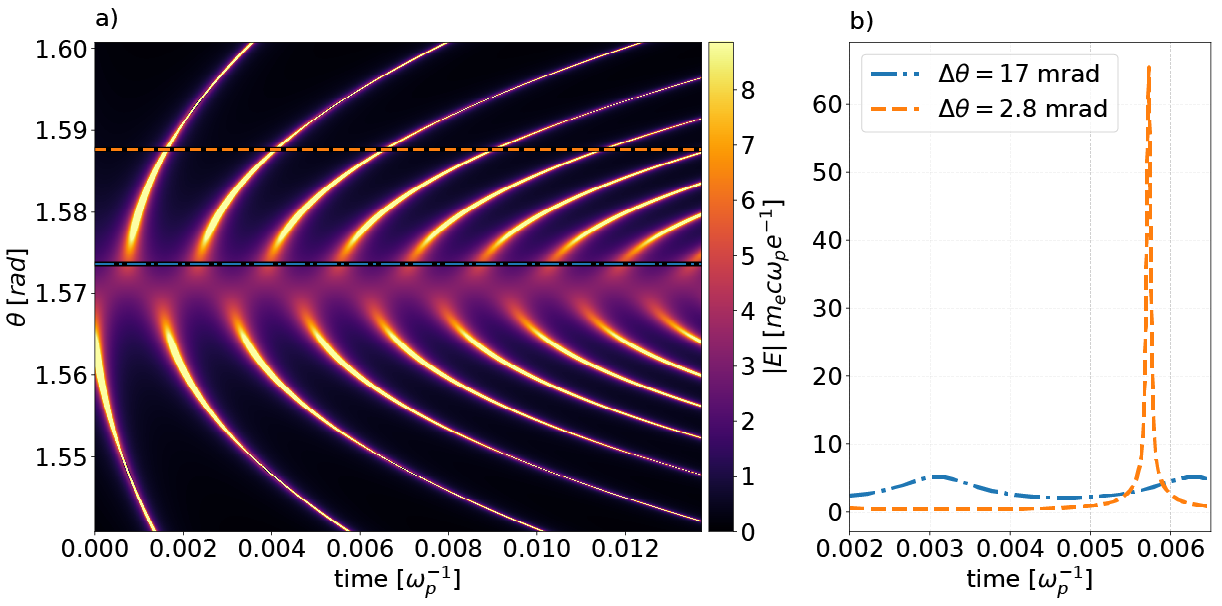Radiation from charged particles in a helical trajectory
The scales associated with this radiation are typically orders of magnitude smaller than the scales associated with the particle’s motion, thus, resolving such small scales would increase the number of operations beyond what is currently computationally possible. Consequently, the spatiotemporal behaviour of the radiation emitted by charged particles either in a plasma or a synchrotron environment remains fairly unexplored and to the best of our knowledge, no theoretical predictions have been made on the spatiotemporal signature of any kind of motion. However, the spectral properties of radiation are well documented for some common types of motion as typical synchrotron light sources generate radiation by making relativistic, ultra-fast particles undergo a sinusoidal or helical motion inside periodic magnetic structures known as wigglers or undulators. Such conditions can also be obtained in a plasma using relativistic plasma waves instead of magnetic structures or EM fields. The Radiation Diagnostic for OSIRIS (RaDiO) evades this problem by capturing the radiated fields in a grid separate from the simulation grid, using the Liénard-Wiechert Potentials. This way, it is possible to capture the radiation without increasing the resolution of the PIC simulation.
In this way, several radiation favorable scenarios have been idealized and thoroughly studied to the point where accurate theoretical predictions can be made. The conditions required for these predictions to hold are usually not met in collective systems of particles, where coherence effects may be present, as the interactions between particles normally affect their trajectories, introducing deviations from the ideal sinusoid or helix. These simulations often use a single particle, in that case, the usual normalizations no longer make sense as there is no plasma involved. Therefore, in this simulation, ωp and n0 are just arbitrary normalization constants.
The helical trajectory can be seen as a composition of two sinusoidal trajectories in perpendicular planes. This trajectory, as depicted in the animation was first proposed by Brian Kincaid [1] as an alternative to the conventional sinusoid explored in the previous section, potentially yielding an improvement of several orders of magnitude in intensity and brightness.
We analysed the radiation emitted by a highly relativistic particle (γ=100) undergoing a small amplitude helix, rb=0.02 c/ωp, with frequency, ωβ=ωp.
The detector lied on the x3x1 plane with a radius of 105 c/ωp and angular aperture of 0.03 rad. The detector had a temporal resolution of 1.33 x 10-5 ωp-1. The spatiotemporal signature of the detected field is displayed on Figure 1(a), this time, it is clear that the maximum intensity radiation is located off-axis, displaying a significant drop in the field intensity on-axis. The parabolic structures that erupt from the axis are broader on-axis, and become thinner for higher apertures, as evidenced by the lineouts of Figure 1(b).

Figure 1: Spatiotemporal profile of the magnitude of the electric field at the spherical detector. b) Temporal close-up of the lineouts of the spatiotemporal profile. The vertical axis of panel b) and the color bar of panel a) share the same units.
In this animation, we follow a relativistic (γ=100) charged particle (in blue) undergoing a helical trajectory, in a first stage the emitted radiation, which is mostly confined within a cone with an aperture of (1/γ), is represented by pink rings that spread out as they propagate at the speed of light. As the camera pans towards a perpendicular point of view we see that the emitted beam is actually an ultra-short pulse, and a close up shows us that the typical wavelength of the radiation is much smaller that the wavelength of the particle’s motion (γ2 times smaller). We then accelerate towards the far-field detector where we see the same radiation, but this time as captured by RaDiO.
References:
[1] B. M. Kincaid, A short-period helical wiggler as an improved source of synchrotron radiation. Journal of Applied Physics, 48(7), 2684–2691 (1977)
For more information, see M. Pardal, J. Vieira, R. A. Fonseca, and A. Sainte-Marie, Spatiotemporal structure of hard x-rays in particle-in-cell codes, PP11.00021, 60th Annual Meeting of the APS Division of Plasma Physics, November 5–9 (2018), more details here.








